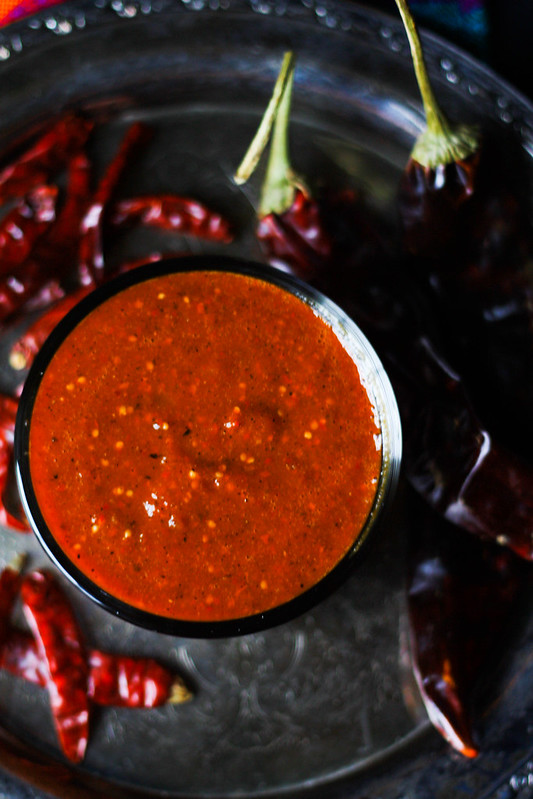Do you remember those firecracker chile de árbol peppers that I was telling you about? Well, here is the salsa featuring those fiery devils. I love making this salsa to go with tacos, but tonight I made it to go along with some chicken and potato flautas. It was perfect!
If you eat this salsa with chips alone, it will definitely feel hot on your tongue. You may need a glass of horchata. But, if you put this salsa on top of tacos, flautas, sopes, or tostadas, it adds flavor. It will not burn your mouth because it is mellowed out by all of the other fixings.
The only time-consuming part of making it is rehydrating the chiles. Other than that, it comes together pretty easily. It will last in the refrigerator for about 3-5 days. You will find that this salsa is a crowd favorite. You may even get requests for it on taco night (wink, wink…Stephen.)
Salsa de Chile de Árbol
Click here for printable recipe.
Chile de Árbol Salsa (Makes about 2 cups)
300 g tomatillos (about 4-5 medium-sized)
2 guajillo chiles
1 puya chile (optional, but I think it adds extra flavor)
8-10 chiles de árbol
1 clove garlic
¼ cup cooking water (or less)
½ tsp salt
→Fill a small saucepan about halfway with water. Place over medium heat. You will be putting the chiles in this later to rehydrate.
→Remove the stems from the guajillo, puya, and árbol chiles. Remove the veins and seeds from the guajillo and puya chiles. You do not need to remove the seeds from the árbol chiles.
→Place the chiles on a warm griddle or comal. Lightly toast them. You will know they are ready when they are slightly fragrant. This does not take long, so don’t walk away. You do not want to burn them or they will make the salsa bitter. Place the chiles in the simmering water. Simmer for about 5 minutes. Then, turn off the heat, place a lid on the saucepan, and let them soak for an additional 15 minutes.
→Remove the husks from the tomatillos and wash them to remove the sticky residue. Cut them in half and place them on a griddle or comal to roast. Roast them on both sides until their skin has blackened in some areas. They will lighten in color and will become soft and juicy. Place in blender.
→You can roast the garlic at the same time as the chiles. Leave the clove in its papery skin and roast until it is slightly blackened on the outside. Remove from the papery skin (it will be somewhat soft) and place in blender.
→Once the chiles have rehydrated, remove them from their cooking liquid with a pair of tongs and place them in the blender. Add ¼ cup of the cooking water (a little at a time) and the salt.
→Blend the tomatillos, garlic, and chiles on medium-high speed for 1 minute. Add more cooking liquid as necessary. Adjust salt as needed.
NOTES:
- I’ve made this salsa with and without the puya chile. There is not a great difference in flavor, but I think it adds something extra.
- I like to use a kitchen scale to weigh my tomatoes when making salsas. I think it creates a more consistent salsa from time to time.
- I mainly use table salt in my salsas. If you are using sea/kosher salt, you may need to add a little more because the granules are larger.
Recipe Source: Loosely adapted from Salsas Mexicanas by Ricardo Muñoz Zurita



I need to try this salsa…the chile trio sounds delicious! So glad to see that you’ve had time to write.:) –Lola
It was so nice to be able to have a little time off of school. I’m sure you’re finding this in Colorado, but these winter months kill me in terms of photography. When I leave in the morning, it’s dark, and when I come home it’s dark, too! Makes me want summer even more. 😉
I must make this salsa. Just gotta get a puya and will be all set to try it. Will let you know how it turns out. Cheers!
Hi Girelle! Thanks so much for stopping by. I LOVE this salsa, and I’m sure you will, too. The chile puya is not absolutely necessary. You can omit it if you want. I was looking at your blog, and I noticed that we have something in common. I fell in love with Mexico in 2007, when I visited/studied there for the first time. I went back in 2009 to teach English and fell in love a second time, this time with a guy from Veracruz 🙂 He now lives in the U.S. with me. What part of Veracruz is your husband from?
Is this Salsa spicy? I’m looking for a spicy recipe.
Hi Heather!
Yes 🙂 Chile de árbol salsa is pretty spicy. The more chiles you add the spicier it will be. Some of the spiciest dried chiles are the chiles de árbol, piquín, and chipotles. The spicier fresh chiles are the habaneros and serranos. Hope that helps!
Thank you so much! I am making it tonight!
The sauce, using the ingredients listed, is fairly bland. I added three more cloves of garlic and 1/4 cup of white onion, which made it right.